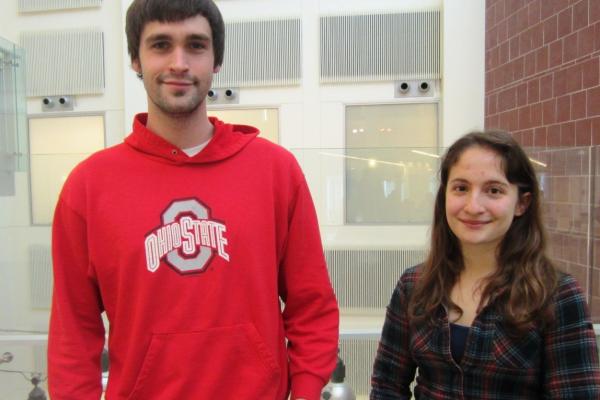Two physics students win honors at the Denman Undergraduate Research Forum

Physics is happy to announce two students won honors at the 20th Annual Denman Undergraduate Research Forum - Tajana Schneiderman won a 1st place and Randall (RJ) Hanna won a 3rd place.
Congratulations to Tajana and Randall and to all of the students who participated in the Denman!
To learn more about their research:
Tajana Schneiderman – 1st place
Advisor: Pablo Sobron (at the SETI Institute)
Abstract: Laser Raman spectroscopy (LRS) and laser-induced breakdown spectroscopy (LIBS) can be used synergistically to characterize the geochemistry and mineralogy of potential microbial habitats and biosignatures. The value of LRS and LIBS has been recognized by the planetary science community: (i) NASA’s Mars2020 mission features a combined LRS-LIBS instrument, SuperCam, and an LRS instrument, SHERLOC; (ii) an LRS instrument, RLS, will fly on ESA’s 2018 ExoMars mission. The advantages of combining LRS and LIBS are evident: (1) LRS/LIBS can share hardware components; (2) LIBS reveals the relative concentration of major (and often trace) elements present in a sample; and (3) LRS yields information on the individual mineral species and their chemical/structural nature. Combining data from LRS and LIBS enables definitive mineral phase identification with precise chemical characterization of major, minor, and trace mineral species. New approaches to data processing are needed to analyze large amounts of LRS+LIBS data efficiently and maximize the scientific return of integrated measurements. Multi-sensor data fusion (MSDF) is a method that allows for robust sample identification through automated acquisition, processing, and combination of data. It optimizes information usage, yielding a more robust characterization of a target than could be acquired through single sensor use. We have developed a fuzzy logic adaptive MSDF model aimed towards the unsupervised characterization of Martian habitats and their biosignatures using LRS and LIBS datasets. Our model also incorporates fusion of microimaging (MI) data – critical for placing analyses in geological and spatial context. Here, we discuss the performance of our novel MSDF model and demonstrate that automated quantification of the salt abundance in sulfate/clay mixtures is possible through data fusion of collocated LRS, LIBS, and MI data.
Randall (RJ) Hanna – 3rd place
Advisor: Douglass Schumacher
Abstract: One of the most exciting aspects of high-intensity short-pulse lasers is their ability to produce beams of energetic protons and neutrons. These intense laser-produced beams may have direct applications in proton cancer therapy and neutron radiography, which conventionally rely on large and expensive particle accelerators or reactors as their particle source. Laser based particle beams are produced by irradiating an ultra-thin film with an incredibly intense and brief pulse of laser light. The only problem with utilizing this mechanism as a source of secondary radiation is that targets cannot be placed in front of the laser fast enough to match the particle flux of traditional sources. My research is part of a DARPA funded project to develop a target that will increase the repetition rate of high-intensity laser systems. In order to do this, vacuum-compatible liquid films were implemented in place of traditional metal foil targets. These liquid targets have the ability to reform themselves inside the target chamber, eliminating the need for replacement and realignment between every shot. The thickness of these free-standing films can also be tuned from 10nm – 10µm using techniques developed over the past year. The ability to change thickness allows this target to be optimized for use on a variety of different laser systems. A prototype target apparatus has been built which can form liquid targets at 0.33Hz with a position repeatability of 2µm RMS from optimal laser focus. This new target is poised to increase the firing rate of OSU’s SCARLET laser system from once an hour, to once every minute. An additional target prototype is currently in the early stages of development which will increase the firing rate to several times per second.
For more on the Denman - https://denman.osu.edu/Home.aspx
